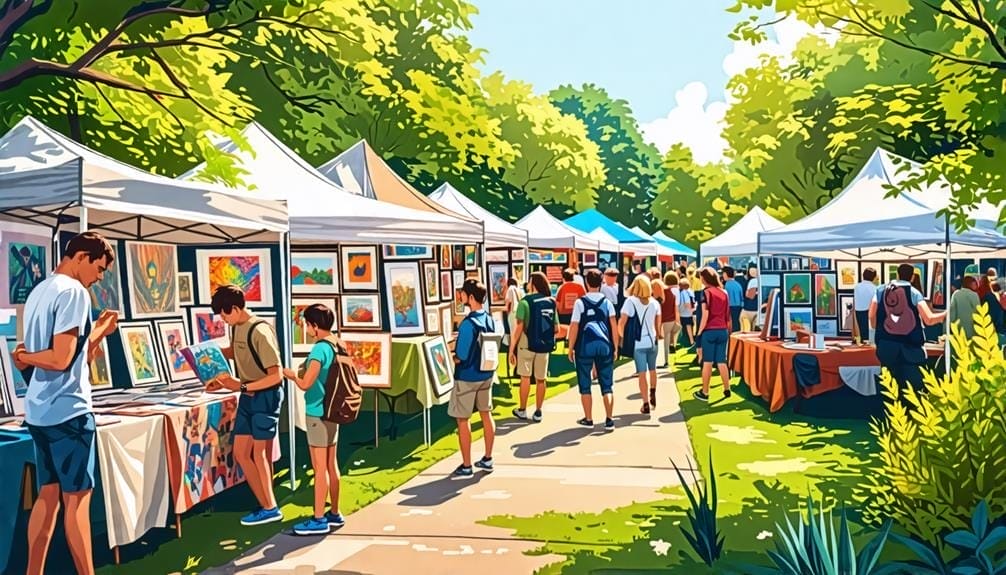One easy way for artists to test the waters of selling their work is to market themselves at Art Fairs and Festivals and Outdoor Exhibitions. Understanding the methods and differences in these venues will take some skill and practice. Here are some guidelines.
Finding An Art Event
Many cities, counties, and organizations sponsor these shows. There are Art Associations that list many of these local Art exhibitions. Make sure to start with these organizations. For nationwide listings, here are links to two show directories:
Artfairsourcebook.com – Greg Lawyer Art Fair Sourcebook
Festivalnet.com – From local shows to major festivals
Choose shows that interest you and are within your geographical area. Call or email the contact person of the show for an application if it does not appear online.
DISCOVER MORE: Legally Selling Art on the Street: What Every Artist Needs to Know
Creating a Winning Art Show Application
You’ve got one shot to make a great first impression, so take your time and get it right! Reviewing application deadlines and submission requirements carefully is crucial. Double-check that you meet all the criteria and submit your application on time – it’s worth the extra effort.

When showcasing your artwork, high-quality digital images are a must. These images will be the jurors’ first glimpse into your creative world, so ensure they accurately represent your pieces. Follow the entry fees and submission format rules to avoid any missteps that could lead to rejection.
Sometimes, you’ll need to create a cohesive presentation of your work, including a booth slide or layout plan. This helps jurors visualize your display set up and see your vision come to life.
Remember, responses can vary – you might get accepted, rejected, or put on standby. Be prepared for each outcome and stay flexible. With a solid application and a positive attitude, you’ll be well on your way to showcasing your art at a top fair or festival!
Create a Showstopping Art Booth Display
Imagine walking into an art fair and being immediately drawn to a stunning display that showcases an artist’s work in a visually appealing and cohesive way. That’s what you want to achieve! To capture the attention of potential buyers, think of your display as a curated experience that tells a story.
Start with a consistent color scheme and framing style that ties all your pieces together. This creates a unified aesthetic that invites viewers to explore your artwork. Then, get creative with your display by incorporating varying levels and heights. This adds visual interest and ensures each piece gets the attention it deserves.
Don’t forget about the practicalities – a sturdy, white canopy will protect your artwork from the elements while maintaining a professional look. And remember, less is often more. Keep your display organized, signage clear, and let your artwork be the star of the show.

Finally, lighting can make all the difference. Highlight your key pieces and create an inviting atmosphere that encourages viewers to engage with your artwork. Following these tips will create a showstopping display that draws in potential buyers and leaves a lasting impression.
DISCOVER MORE: 7 Powerful Art Booth Display Ideas for Artists
Developing Effective Marketing Materials
Having the right marketing materials can make all the difference when promoting your artwork at art fairs and festivals. These materials are your chance to showcase your art, share your story, and connect with potential buyers.
Here are the essential materials you’ll need:
- Business Cards: These should include your contact information, social media handles, and a small artwork sample. Think of them as a mini portfolio that attendees can take with them. Tip: Postcard Puzzles with your art are a great giveaway!
- Brochures: Provide detailed information about your artwork, including artist statements, techniques, and pricing. This will help visitors understand your vision and make informed purchasing decisions.
- Signage: Your name and artwork prices should be clearly displayed at your booth. This will help attract visitors and make finding the information they need easy.
To get the most out of your marketing materials, remember to:
- Design brochures that educate visitors about your work and prices, encouraging them to explore your art further.
- Distribute business cards freely to attendees, making it easy for them to contact you after the event.
Making Sales a Breeze: Accepting Payment at Art Shows and Festivals
The thrill of selling your art at a show or festival is exhilarating, but it’s essential to be prepared for the practical side of things – accepting payment! You want to make it easy for customers to buy your art, so having a reliable system is key to a successful show.

Imagine a customer falling in love with your piece, only to find out you can’t accept their preferred payment method. Don’t let that happen! Be prepared to accept various payment types, including cash, checks, and credit/debit cards.
Here are some popular services to accept payment in an outdoor location:
- Square Reader: A mobile credit card reader plugs into your smartphone or tablet.
- PayPal Here: A mobile payment processing service that allows you to accept credit card payments using your smartphone or tablet.
- Venmo: A peer-to-peer payment service that allows customers to pay using their mobile devices.
- Stripe Terminal: A mobile payment terminal that allows you to accept credit card payments in-person.
- Clover Go: A mobile credit card reader that accepts payments on the go.
- SumUp: A mobile payment processing service that allows you to accept credit card payments using your smartphone or tablet.
- Zettle: A mobile payment processing service that allows you to accept credit card payments using your smartphone or tablet.
These services are all great options for accepting payment in an outdoor location, such as an art show or festival. They’re easy to use, secure, and offer competitive pricing.
Build A Mailing List
One activity that is often overlooked is collecting contact information of people interested in your art. All you need is their name and email address and their approval to send them emails from time to time with show details, new art announcements, etc.
For beginning exhibitors at Art Fairs and Festivals, this should help to get you on your way to a successful art fair – and hopefully some sales.






